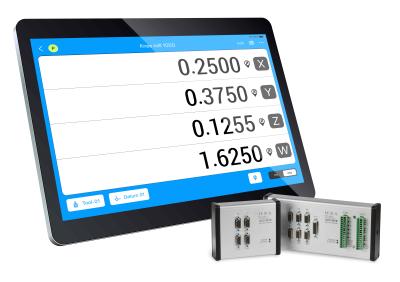
Offering machinists a pioneering way to a new Bluetooth-enabled digital readout, HEIDENHAIN presents the highly anticipated ACU-RITE-brand droPWR. This new droPWR is a first-of-its-kind system to enable an iPad® tablet to become a digital readout (DRO), doing everything an ACU-RITE DRO can except without cables between tablet and machine tool! The droPWR will first be shown at IMTS 2022 in Chicago on Sept. 12-17.
Bluetooth technology along with an IBT interface box in the droPWR system allows connection to multiple machine configurations in one tablet including for milling, turning, and grinding machines with up to six axes. Designed to be simple and functional, this tablet DRO can be moved and used with various machines, making it perfect for many production environments such as small shops and students in shop class.
The new droPWR takes manual machining to the next level by combining the familiar intuitive user experience from the traditional ACU-RITE DROs with modern touch screen conventions. The new droPWR system includes the new software, an IBT interface box suitable for the machine tool and relevant encoders/brackets if needed. A tablet with iOS 15 or greater is required. And with its simple on-boarding configuration set up, a user can quickly establish connection to its intended machine(s).
Contact Details
Related Glossary Terms
- gang cutting ( milling)
gang cutting ( milling)
Machining with several cutters mounted on a single arbor, generally for simultaneous cutting.
- grinding
grinding
Machining operation in which material is removed from the workpiece by a powered abrasive wheel, stone, belt, paste, sheet, compound, slurry, etc. Takes various forms: surface grinding (creates flat and/or squared surfaces); cylindrical grinding (for external cylindrical and tapered shapes, fillets, undercuts, etc.); centerless grinding; chamfering; thread and form grinding; tool and cutter grinding; offhand grinding; lapping and polishing (grinding with extremely fine grits to create ultrasmooth surfaces); honing; and disc grinding.
- milling
milling
Machining operation in which metal or other material is removed by applying power to a rotating cutter. In vertical milling, the cutting tool is mounted vertically on the spindle. In horizontal milling, the cutting tool is mounted horizontally, either directly on the spindle or on an arbor. Horizontal milling is further broken down into conventional milling, where the cutter rotates opposite the direction of feed, or “up” into the workpiece; and climb milling, where the cutter rotates in the direction of feed, or “down” into the workpiece. Milling operations include plane or surface milling, endmilling, facemilling, angle milling, form milling and profiling.
- turning
turning
Workpiece is held in a chuck, mounted on a face plate or secured between centers and rotated while a cutting tool, normally a single-point tool, is fed into it along its periphery or across its end or face. Takes the form of straight turning (cutting along the periphery of the workpiece); taper turning (creating a taper); step turning (turning different-size diameters on the same work); chamfering (beveling an edge or shoulder); facing (cutting on an end); turning threads (usually external but can be internal); roughing (high-volume metal removal); and finishing (final light cuts). Performed on lathes, turning centers, chucking machines, automatic screw machines and similar machines.

